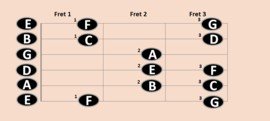Beginner classical guitar lesson 7 : Notes on the E string
These lessons, designed for the beginner classical guitar player, build step by step with each lesson building on the previous lesson in the following ways: (i) knowledge of guitar technique; (ii) familiarity with music reading and (iii) strengthening - and in a safe way - your hands. If you haven't played through the lessons leading to Lesson 7, I suggest you go back and play through those. Remember that the house with the solid foundation is stronger in the long run.
I’m getting a lot of messages from people coming here because they want to learn to play guitar as part of worship. If this is you, you might want to join Aaron Anastasi’s programme. Aaron is a musician and a worship leader. He put together a step by step programme for aspiring Christian musicians. If you're interested, you can use the exercises and advice in learn-classical-guitar-today to develop your finger strength and dexterity and Aaron's lessons to work on strumming and worship music.
CLICK HERE TO LEARN WORSHIP GUITAR !!
Beginner Classical Guitar Lesson 7 - Aims
- Become familiar with and practice using the notes located on the E string (6th string) and play these together with notes on all the other five strings on the guitar.
- Become fully familiar with notes in the first position on the guitar.
- Become more comfortable with music in two voices (review lesson 4 on this topic)
- Using the p finger, together with i-m right hand alternation.
Exercise 20
Exercise 1 to 19 are included in previous lessons

Play along to the accompaniment provided for this beginner classical guitar lesson
The mp3 for this lesson is provided below. Practice by setting your metronome at a very slow pace. Slowly push up the speed until you can play it confidently at a metronome speed of 80 bmp. When you can play it confidently at this speed, you can play along to the accompaniment provided.
| |
I’m getting a lot of messages from people coming here because they want to learn to play guitar as part of worship. If this is you, you might want to join Aaron Anastasi’s programme. Aaron is a musician and a worship leader and put together a step by step programme for aspiring Christian musicians. If you are interested, you can use the exercises and advice in learn-classical-guitar-today to develop your finger strength and dexterity and Aaron's lessons to work on strumming and worship music. GO HERE TO LEARN WORSHIP GUITAR
Notes on the study
Use the p-, i- and m- fingers as indicated in the score. Notice that the fingering is provided for only the first bar. The fingering approach provided in this bar is to be used for the rest of the piece of music. This approach of providing the fingering in only the first bar is frequently used in guitar scores. It suggests that the fingering approach applied in the first bar is to be applied to the remaining bars that have a similar musical structure.
This piece, contrary to the previous piece which was in 2/4, is in 4/4 which represents 4 beats in the bar. Review music theory for an overview of musical timing.The metronome speed is a minimum of 100 bpm for this piece, although the faster you play it the better it sounds. Important though is to keep the notes really smooth otherwise it tends to sound pretty raggedy at faster speeds.
Tips for this exercise
Here are the key tips and suggestions for working with this exercise. These tips are pretty much the basis of all good playing and you should write or stick this list up in your practice area and look at it again and again.
Use the correct fingering: Where indicated use the p finger and i finger. You should be familiar with the i-m combinations. If you are not, you might wish to go back to earlier lessons where this combination was practiced.
Notice the note values: particularly in the context of playing music with two voices as you will be doing in these exercises. Also, the addition of the quaver note. If you need to revise the note values go to music theory.
Build up speed slowly: increase the metronome speed slowly and in small increments of no more than five bpm until you are comfortable at the faster speeds. I was taught to increase speed by doing three bpm forward and then going two bpm backwards. It's one idea.
Watch your 'c' finger (your pinky) and check what it is doing while the other fingers are moving about. Beginners often have this finger flying around. This is a very bad habit which you should become aware of at this early stage as it leads to very tired hands and excessive movement. Simply become aware of when it happens and try and decrease the movement of the pinky when the finger is not in use. You can also look at Guitar Finger Names which directs you to some composers who’ve designed exercises to strengthen the pinky. Starting these exercises now can speed up your development by years. I know of guitarists who’ve given up playing because they can’t get their hands to work properly. When analysed, it becomes clear that a weak and unco-ordinated pinky is the obstacle.
See the diagram below for notes on the E string (6th string) and check which fingers to use in each fret.

Alternately, review the notes on the fretboard provided.